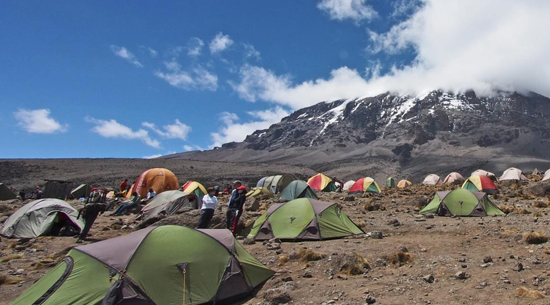7 Days Rongai Route
Day 1: Rongai Gate (1,800m/5,900ft) to First Cave Camp (2,600m/8,400ft)
After an early breakfast in Moshi, drive to the Rongai Gate near the Kenya border. After registering at the gate, begin your climb to Uhuru Peak, the roof of Africa. During the first day, hike through forests where you may see and hear wildlife. Eat lunch on the trail before continuing to the first campsite. Rongai ascends via the less forested northern side of the mountain.
Rongai Route is one of the least crowded routes on Kilimanjaro because of the long drive to the gate. The Rongai trail is thought to have the best chance of viewing wildlife.
Day 2: First Cave Camp (2,600m/8,400ft) to Kikelewa Camp (3,600m/11,810ft)
During day two hike through Kilimanjaro’s moorland. The Rongai route is relatively short and steep, making for shorter hiking times. During this day, view Mawenzi Peak ahead.
Day 3: Kikelewa Camp (3,600m/11,810ft) to Mawenzi Tarn Camp (4,330m/14,200ft)
This day is an acclimatization day, allowing you to hike in the beginning of the day and rest in the afternoon and evening. The hike is relatively short but steep. The Mawenzi Tarn campsite is situated below Mawenzi Peak and offers stunning views of both Mawenzi and Kibo.
Day 4: Mawenzi Tarn Camp
Day four is an acclimatization day at Mawenzi Tarn. We advise hiking a bit higher this day before returning to Mawenzi Tarn in the afternoon.
Day 5: Mawenzi Tarn Camp (4,330m/14,200ft) to Kibo Camp (4,750m/15,580ft)
Cross the lunar landscape of the saddle on this day to arrive at the final campsite. Kibo Camp is situated directly below the Kibo cone, giving you views of your final destination.
Day 6: Kibo Camp (4,750m/15,580ft) to Uhuru Peak (5,895m/19,340ft) to Horombo Hut (3,720m/12,200ft)
Around midnight, begin the final ascent to Uhuru Peak, the highest point in Africa. For the next six hours, hike by the light of your flashlight. The ascent to the crater rim is the most challenging part of the entire trek. The trail is very steep until you reach the crater rim at Gilman’s Point.
The hike from Gilman’s to Uhuru Peak is a gradual climb and, as far as hikes go, not very difficult. The altitude, however, makes the hike long and tiring. The crater rim hike takes approximately two hours. Upon reaching Uhuru, take photos of your guide and group at the peak before beginning the descent to Horombo Hut.
Day 7: Horombo Hut (3,720m/12,200ft) to Marangu Gate (1,800m/5,905ft)
After breakfast, finish the trek with a descent to Marangu Gate. Your last hike on Kilimanjaro is a beautiful one, passing through Kilimanjaro’s cloud forest. Watch your step during the descent, as the trail can be slippery. Ascend Tanzania vehicles will be waiting at Marangu Gate to take you back to Moshi. You will be able to buy t-shirts and sodas at the gate.

Rongai Route Description
Our 7 day Rongai Route trek comes nearer from the north and is a standout amongst the least frequented trails on Kilimanjaro, which is ideal for those searching for an increasingly untainted wilderness experience.
The Rongai Route trek comes closer from the north and is a standout amongst the least frequented trails on Kilimanjaro, which is ideal for those searching for a more ‘wild’ encounter. Is anything but a ‘simpler’ Kilimanjaro route, yet the initial couple of days are somewhat shorter, and the pace is increasingly loose – offering great acclimatization. Through timberland, the trail climbs relentlessly up to Mawenzi pool in the shadow of Mawenzi Peak, before intersection the fruitless scene of ‘The Saddle’. From base camp at Kibo it is an intense yet compensating rising up to Kilimanjaro’s summit by means of Gillman’s Point and Stella Point – where you will feel on top of the world!


